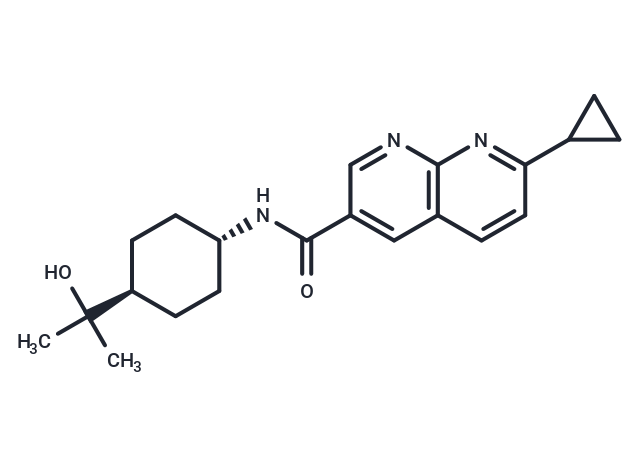Shopping Cart
Remove All Your shopping cart is currently empty
Your shopping cart is currently empty
HPGDS inhibitor 3 is a powerful oral compound that selectively inhibits the hematopoietic prostaglandin D synthase (H-PGDS). With an IC50 value of 9.4 nM and EC50 of 42 nM, it demonstrates high potency in peripherally restricting H-PGDS. Moreover, HPGDS inhibitor 3 exhibits excellent selectivity with no associated central nervous system toxicity. This compound also possesses favorable pharmacokinetic properties in mouse, rat, and dog models. Additionally, HPGDS inhibitor 3 displays noteworthy anti-inflammatory activity [1].

| Pack Size | Price | USA Warehouse | Global Warehouse | Quantity |
|---|---|---|---|---|
| 25 mg | $3,970 | 6-8 weeks | 6-8 weeks | |
| 50 mg | $5,550 | 6-8 weeks | 6-8 weeks | |
| 100 mg | $7,490 | 6-8 weeks | 6-8 weeks |
| Description | HPGDS inhibitor 3 is a powerful oral compound that selectively inhibits the hematopoietic prostaglandin D synthase (H-PGDS). With an IC50 value of 9.4 nM and EC50 of 42 nM, it demonstrates high potency in peripherally restricting H-PGDS. Moreover, HPGDS inhibitor 3 exhibits excellent selectivity with no associated central nervous system toxicity. This compound also possesses favorable pharmacokinetic properties in mouse, rat, and dog models. Additionally, HPGDS inhibitor 3 displays noteworthy anti-inflammatory activity [1]. |
| In vivo | HPGDS inhibitor 3 (compound 1y), administered orally (PO) and intravenously (IV), demonstrates lower IV clearance, a similar steady-state volume of distribution, and an extended terminal half-life, along with high oral bioavailability and minimal brain exposure in mice, rats, and dogs. At dosages ranging from 0.003 to 1 mg/kg (PO; single administration), it dose-dependently reduces PGD2 levels to baseline and inhibits LPS-induced increases of PGD2 in plasma and skeletal muscle. Furthermore, dosages of 1, 3, and 10 mg/kg (PO; once daily for 16 days) significantly improve and expedite the functional recovery of injured limb muscles, with the greatest efficacy observed at ≥10 mg/kg daily. Tolerance levels vary by species and dosage, with rats tolerating up to 30 mg/kg/day over 7 days and dogs up to 30 mg/kg/day over 4 days without adverse effects, though higher doses are not tolerated. Pharmacokinetic analysis reveals that, across species, HPGDS inhibitor 3 maintains a low brain-to-blood ratio, reaffirming its safety and efficacy profile for potential therapeutic applications. |
| Molecular Weight | 353.46 |
| Formula | C21H27N3O2 |
| Cas No. | 2255311-93-2 |
| Smiles | C(N[C@@H]1CC[C@@H](C(C)(C)O)CC1)(=O)C2=CC3=C(N=C(C=C3)C4CC4)N=C2 |
| Storage | Powder: -20°C for 3 years | In solvent: -80°C for 1 year | Shipping with blue ice/Shipping at ambient temperature. |
| Size | Quantity | Unit Price | Amount | Operation |
|---|

Copyright © 2015-2026 TargetMol Chemicals Inc. All Rights Reserved.